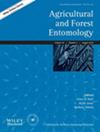Advancing social insect research through the development of an automated yellowjacket nest activity monitoring station using deep learning
IF 1.8
3区 农林科学
Q2 ENTOMOLOGY
引用次数: 0
Abstract


利用深度学习开发黄蜂巢活动自动监测站,推进社会昆虫研究
我们介绍了自主监测站的开发和验证情况,该监测站可识别和记录社会性昆虫进出蜂群的活动。硬件包括一个照明通道和一个用于捕捉黄蜂活动的固定摄像头。此外,还开发了一个专门的后处理软件,用于识别所记录个体的移动方向和种姓。验证结果表明,该模型可以非常准确地检测到工蜂、无人蜂和雌蜂的存在,而运动方向只对工蜂和无人蜂准确,对雌蜂则不准确。软件和硬件的进一步发展应能提高精确度,尤其是在生殖个体的移动方向方面。这一创新工具为研究人员提供了快速、便捷的数据,在推动生态和行为研究方面具有巨大潜力。通过了解蜂群中黄蜂个体的活动模式,可以深入了解影响其生长、觅食模式和繁殖个体行为的因素。最终,这些信息可被纳入有效的管理计划,以控制生态和生产系统中的有害社会昆虫种群。
本文章由计算机程序翻译,如有差异,请以英文原文为准。
求助全文
约1分钟内获得全文
求助全文
来源期刊

Agricultural and Forest Entomology
农林科学-昆虫学
CiteScore
3.60
自引率
6.20%
发文量
66
审稿时长
>24 weeks
期刊介绍:
Agricultural and Forest Entomology provides a multi-disciplinary and international forum in which researchers can present their work on all aspects of agricultural and forest entomology to other researchers, policy makers and professionals.
The Journal welcomes primary research papers, reviews and short communications on entomological research relevant to the control of insect and other arthropod pests. We invite high quality original research papers on the biology, population dynamics, impact and management of pests of the full range of forest, agricultural and horticultural crops.
 求助内容:
求助内容: 应助结果提醒方式:
应助结果提醒方式:


